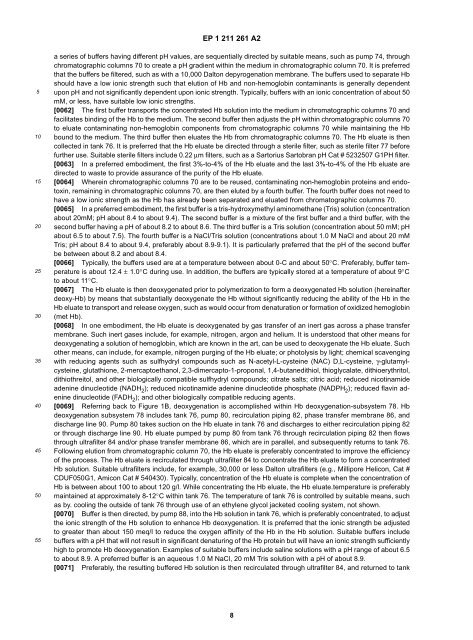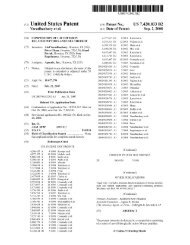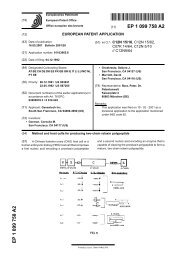EP 1 211 261 A2
EP 1 211 261 A2
EP 1 211 261 A2
You also want an ePaper? Increase the reach of your titles
YUMPU automatically turns print PDFs into web optimized ePapers that Google loves.
<strong>EP</strong> 1 <strong>211</strong> <strong>261</strong> <strong>A2</strong>510152025303540455055a series of buffers having different pH values, are sequentially directed by suitable means, such as pump 74, throughchromatographic columns 70 to create a pH gradient within the medium in chromatographic column 70. It is preferredthat the buffers be filtered, such as with a 10,000 Dalton depyrogenation membrane. The buffers used to separate Hbshould have a low ionic strength such that elution of Hb and non-hemoglobin contaminants is generally dependentupon pH and not significantly dependent upon ionic strength. Typically, buffers with an ionic concentration of about 50mM, or less, have suitable low ionic strengths.[0062] The first buffer transports the concentrated Hb solution into the medium in chromatographic columns 70 andfacilitates binding of the Hb to the medium. The second buffer then adjusts the pH within chromatographic columns 70to eluate contaminating non-hemoglobin components from chromatographic columns 70 while maintaining the Hbbound to the medium. The third buffer then eluates the Hb from chromatographic columns 70. The Hb eluate is thencollected in tank 76. It is preferred that the Hb eluate be directed through a sterile filter, such as sterile filter 77 beforefurther use. Suitable sterile filters include 0.22 µm filters, such as a Sartorius Sartobran pH Cat # 5232507 G1PH filter.[0063] In a preferred embodiment, the first 3%-to-4% of the Hb eluate and the last 3%-to-4% of the Hb eluate aredirected to waste to provide assurance of the purity of the Hb eluate.[0064] Wherein chromatographic columns 70 are to be reused, contaminating non-hemoglobin proteins and endotoxin,remaining in chromatographic columns 70, are then eluted by a fourth buffer. The fourth buffer does not need tohave a low ionic strength as the Hb has already been separated and eluated from chromatographic columns 70.[0065] In a preferred embodiment, the first buffer is a tris-hydroxymethyl aminomethane (Tris) solution (concentrationabout 20mM; pH about 8.4 to about 9.4). The second buffer is a mixture of the first buffer and a third buffer, with thesecond buffer having a pH of about 8.2 to about 8.6. The third buffer is a Tris solution (concentration about 50 mM; pHabout 6.5 to about 7.5). The fourth buffer is a NaCl/Tris solution (concentrations about 1.0 M NaCl and about 20 mMTris; pH about 8.4 to about 9.4, preferably about 8.9-9.1). It is particularly preferred that the pH of the second bufferbe between about 8.2 and about 8.4.[0066] Typically, the buffers used are at a temperature between about 0-C and about 50°C. Preferably, buffer temperatureis about 12.4 ± 1.0°C during use. In addition, the buffers are typically stored at a temperature of about 9°Cto about 11°C.[0067] The Hb eluate is then deoxygenated prior to polymerization to form a deoxygenated Hb solution (hereinafterdeoxy-Hb) by means that substantially deoxygenate the Hb without significantly reducing the ability of the Hb in theHb eluate to transport and release oxygen, such as would occur from denaturation or formation of oxidized hemoglobin(met Hb).[0068] In one embodiment, the Hb eluate is deoxygenated by gas transfer of an inert gas across a phase transfermembrane. Such inert gases include, for example, nitrogen, argon and helium. It is understood that other means fordeoxygenating a solution of hemoglobin, which are known in the art, can be used to deoxygenate the Hb eluate. Suchother means, can include, for example, nitrogen purging of the Hb eluate; or photolysis by light; chemical scavengingwith reducing agents such as sulfhydryl compounds such as N-acetyl-L-cysteine (NAC) D,L-cysteine, γ-glutamylcysteine,glutathione, 2-mercaptoethanol, 2,3-dimercapto-1-proponal, 1,4-butanedithiol, thioglycalate, dithioerythritol,dithiothreitol, and other biologically compatible sulfhydryl compounds; citrate salts; citric acid; reduced nicotinamideadenine dinucleotide (NADH 2 ); reduced nicotinamide adenine dinucleotide phosphate (NADPH 2 ); reduced flavin adeninedinucleotide (FADH 2 ); and other biologically compatible reducing agents.[0069] Referring back to Figure 1B, deoxygenation is accomplished within Hb deoxygenation-subsystem 78. Hbdeoxygenation subsystem 78 includes tank 76, pump 80, recirculation piping 82, phase transfer membrane 86, anddischarge line 90. Pump 80 takes suction on the Hb eluate in tank 76 and discharges to either recirculation piping 82or through discharge line 90. Hb eluate pumped by pump 80 from tank 76 through recirculation piping 82 then flowsthrough ultrafilter 84 and/or phase transfer membrane 86, which are in parallel, and subsequently returns to tank 76.Following elution from chromatographic column 70, the Hb eluate is preferably concentrated to improve the efficiencyof the process. The Hb eluate is recirculated through ultrafilter 84 to concentrate the Hb eluate to form a concentratedHb solution. Suitable ultrafilters include, for example, 30,000 or less Dalton ultrafilters (e.g., Millipore Helicon, Cat #CDUF050G1, Amicon Cat # 540430). Typically, concentration of the Hb eluate is complete when the concentration ofHb is between about 100 to about 120 g/l. While concentrating the Hb eluate, the Hb eluate.temperature is preferablymaintained at approximately 8-12°C within tank 76. The temperature of tank 76 is controlled by suitable means, suchas by. cooling the outside of tank 76 through use of an ethylene glycol jacketed cooling system, not shown.[0070] Buffer is then directed, by pump 88, into the Hb solution in tank 76, which is preferably concentrated, to adjustthe ionic strength of the Hb solution to enhance Hb deoxygenation. It is preferred that the ionic strength be adjustedto greater than about 150 meq/l to reduce the oxygen affinity of the Hb in the Hb solution. Suitable buffers includebuffers with a pH that will not result in significant denaturing of the Hb protein but will have an ionic strength sufficientlyhigh to promote Hb deoxygenation. Examples of suitable buffers include saline solutions with a pH range of about 6.5to about 8.9. A preferred buffer is an aqueous 1.0 M NaCl, 20 mM Tris solution with a pH of about 8.9.[0071] Preferably, the resulting buffered Hb solution is then recirculated through ultrafilter 84, and returned to tank8




